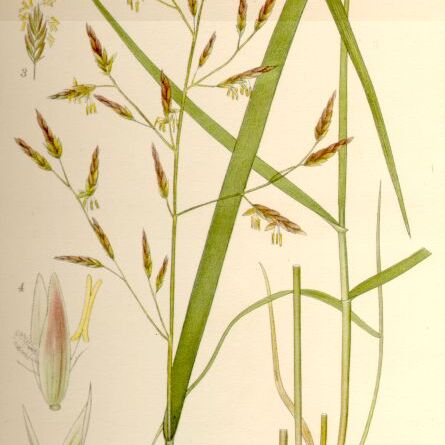Plant loosely tufted; shoots extravaginal. Culms 30–130 cm tall, nodes 2–4. Leaf sheaths glabrous; auricles falcate, glabrous; leaf blades flat or loosely rolled, 10–25 cm × 2–7 mm, glabrous, veins 18–25; adaxial to abaxial sclerenchyma strands present; ligule 0.2–0.5 mm, margin ciliate. Panicle compact except at anthesis, (6–)10–25 cm; branches usually paired, (3.5–)4–6.5 cm, unequal, longer branch with 4–6 spikelets, shorter branch with 1–3 spikelets. Spikelets 8.5–17 mm; florets (2–)4–12; glumes glabrous or scabrid; lower glume (2–)2.6–4(–4.5) mm; upper glume (3–)3.5–5 mm; rachilla internodes scabrid; lemmas (5–)6–8 mm, smooth or scabrid, apex hyaline, acute, rarely awn–tipped; awns 0–2 mm; palea keels scabrid. Anthers (0.5–)2–4.6 mm. Ovary apex glabrous. 2n = 14, 28, 42, 70.
Perennial, caespitose. Culms 30–140 cm high, smooth. Young shoots extravaginal or intravaginal. Leaves: basal sheath margins connate; ligule 0.2–1.5 mm long; auricles glabrous; blade loosely involute or flat, linear, 10–25 cm long, 2–5 mm wide, adaxially glabrous or pubescent. Panicles open at anthesis, otherwise contracted, (6–) 10–15 cm long. Spikelets 9–14 (–17) mm long, with 4–10 bisexual florets. Glumes: lower glume 2.5–4 mm long, 1 (–3)-nerved; upper glume 3.5–6 mm long. Lemma 5–7 (–8) mm long, acute, usually muticous or rarely with awn to 2 mm long, dorsally rounded, obscurely 5-nerved, smooth or scaberulous; awn subapical, to 3 mm long. Caryopsis ellipsoid.
A grass. It forms loose tufts and keeps growing from year to year. It grows 30-120 cm high. It can be erect or spreading. The leaf blades are flat and ribbed above. They are 45 cm long and 3-8 mm wide. They are shiny underneath.

